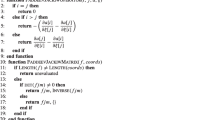Abstract
We study flag manifold sigma models that admit a zero-curvature representation. We show that these models can be naturally viewed as interacting (holomorphic and antiholomorphic) βγ-systems. In addition, using the theory of nilpotent orbits of complex Lie groups, we establish a relation of flag manifold sigma models to the principal chiral model.
Similar content being viewed by others
References
D. Alekseevsky and A. Arvanitoyeorgos, “Riemannian flag manifolds with homogeneous geodesics,” Trans. Am. Math. Soc. 359 (8), 3769–3789 (2007).
O. Brodbeck and M. Zagermann, “Dimensionally reduced gravity, Hermitian symmetric spaces and the Ashtekar variables,” Classical Quantum Gravity 17 (14), 2749–2763 (2000); arXiv:gr-qe/9911118.
D. Bykov, “Complex structures and zero-curvature equations for cr-models,” Phys. Lett. B 760, 341–344 (2016); arXiv: 1605.01093 [hep-th].
D. V. Bykov, “A gauged linear formulation for flag-manifold cr-models,” Theor. Math. Phys. 193 (3), 1737–1753 (2017) [transl. from Teor. Mat. Fiz. 193 (3), 381–400 (2017)].
D. V. Bykov, “The 1/N-expansion for flag-manifold cr-models,” Theor. Math. Phys. 197 (3), 1691–1700 (2018) [transl. from Teor. Mat. Fiz. 197 (3), 345–355 (2018)].
D. Bykov, “Flag manifold σ-models: The \({\textstyle{1 \over N}}\)-expansion and the anomaly two-form,” Nucl. Phys. B 941, 316–360 (2019); arXiv: 1901.02861 [hep-th].
D. Bykov, “Quantum flag manifold cr-models and Hermitian Ricci flow,” arXiv: 2006.14124 [hep-th].
A. G. Bytsko, “The zero-curvature representation for the nonlinear O(3) sigma-model,” J. Math. Sci. 85 (1), 1619–1628 (1997) [transl. from Zap. Nauchn. Semin. POMI 215, 100–114 (1994)]; arXiv: hep-th/9403101.
K. Costello, E. Witten, and M. Yamazaki, “Gauge theory and integrability. I,” ICCM Not. 6 (1), 46–119 (2018); arXiv: 1709.09993 [hep-th].
K. Costello, E. Witten, and M. Yamazaki, “Gauge theory and integrability. II,” ICCM Not. 6 (1), 120–146 (2018); arXiv: 1802.01579 [hep-th].
K. Costello and M. Yamazaki, “Gauge theory and integrability. III,” arXiv: 1908.02289 [hep-th].
P. Crooks, “Complex adjoint orbits in Lie theory and geometry,” arXiv: 1703.03390 [math.AG].
F. Delduc, T. Kameyama, S. Lacroix, M. Magro, and B. Vicedo, “Ultralocal Lax connection for para-complex ℤt-cosets,” arXiv: 1909.00742 [hep-th].
F. Delduc, M. Magro, and B. Vicedo, “On classical q-deformations of integrable cr-models,” J. High Energy Phys. 2013 (11), 192 (2013); arXiv: 1308.3581 [hep-th].
V. A. Fateev, “The sigma model (dual) representation for a two-parameter family of integrable quantum field theories,” Nucl. Phys. B 473 (3), 509–538 (1996).
V. A. Fateev, E. Onofri, and A. B. Zamolodchikov, “Integrable deformations of the O(3) sigma model. The sausage model,” Nucl. Phys. B 406 (3), 521–565 (1993).
V. Ginzburg, “Geometric methods in the representation theory of Hecke algebras and quantum groups,” arXiv: math/9802004 [math.AG].
B. Hoare, N. Levine, and A. A. Tseytlin, “Integrable 2d sigma models: Quantum corrections to geometry from RG flow,” Nucl. Phys. B 949, 114798 (2019); arXiv: 1907.04737 [hep-th].
C. Klimčík, “On integrability of the Yang-Baxter σ-model,” J. Math. Phys. 50 (4), 043508 (2009); arXiv: 0802.3518 [hep-th].
C. Klimčík, “Integrability of the bi-Yang-Baxter σ-model,” Lett. Math. Phys. 104 (9), 1095–1106 (2014); arXiv: 1402.2105 [math-ph].
S. L. Lukyanov, “The integrable harmonic map problem versus Ricci flow,” Nucl. Phys. B 865 (2), 308–329 (2012); arXiv: 1205.3201 [hep-th].
N. A. Nekrasov, “Lectures on curved beta-gamma systems, pure spinors, and anomalies,” arXiv: hep-th/0511008.
E. Witten, “Topological sigma models,” Commun. Math. Phys. 118 (3), 411–449 (1988).
E. Witten, “Two-dimensional models with (0, 2) supersymmetry: Perturbative aspects,” Adv. Theor. Math. Phys. 11 (1), 1–63 (2007); arXiv: hep-th/0504078.
Acknowledgments
I would like to express my sincere gratitude to Andrei Alekseevich Slavnov for his support and warm attitude for many years. I wish him health, cheerfulness, and the pleasure of creative work.
I would like to thank A. Bourget, R. Donagi, S. Frolov, A. Hanany, C. Klimčík, T. McLoughlin, V. Pestun, E. Sharpe, S. Shatashvili, S. Theisen, A. Tseytlin and P. Zinn-Justin for useful discussions, as well as D. Lüst for support. I am grateful to the Institut des hautes études scientifiques (Bures-sur-Yvette, France), where part of this work was done, and in particular to V. Pestun, for hospitality.
Funding
The work is supported in part by the ERC grant in the framework of the European Union “Horizon 2020” program (QUASIFT, grant no. 677368).
Author information
Authors and Affiliations
Corresponding author
Additional information
To Andrei Alekseevich Slavnov on the occasion of his 80th birthday with respect and gratitude
This article was submitted by the author simultaneously in Russian and English
Published in Russian in Trudy Matematicheskogo Instituta imeni V.A. Steklova, 2020, Vol. 309, pp. 89–98.
Rights and permissions
About this article
Cite this article
Bykov, D.V. Flag Manifold Sigma Models and Nilpotent Orbits. Proc. Steklov Inst. Math. 309, 78–86 (2020). https://doi.org/10.1134/S0081543820030062
Received:
Revised:
Accepted:
Published:
Issue Date:
DOI: https://doi.org/10.1134/S0081543820030062




